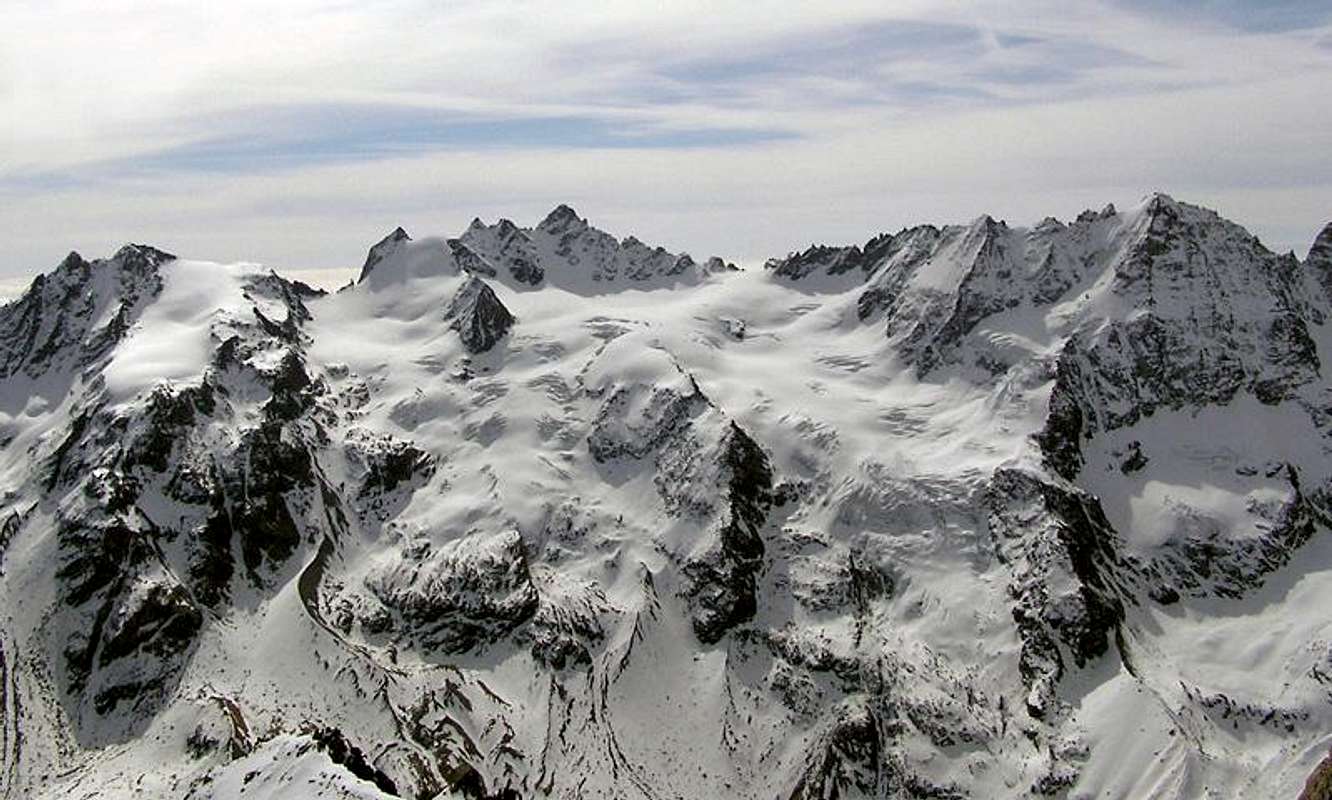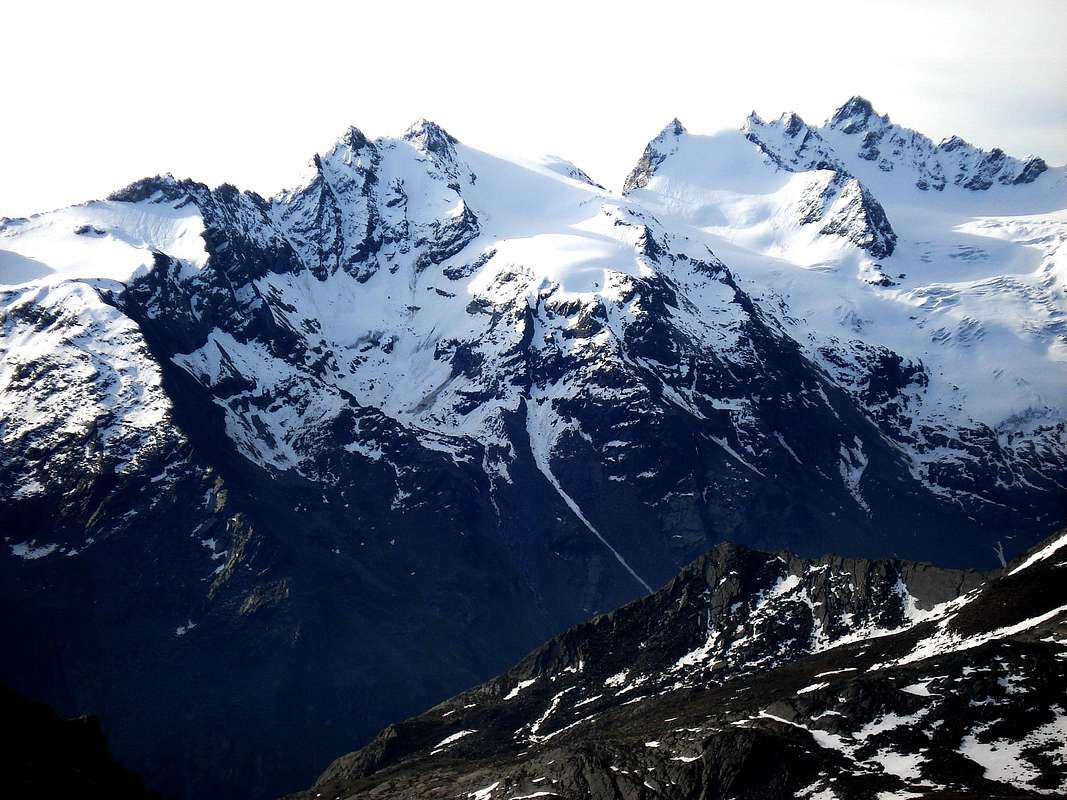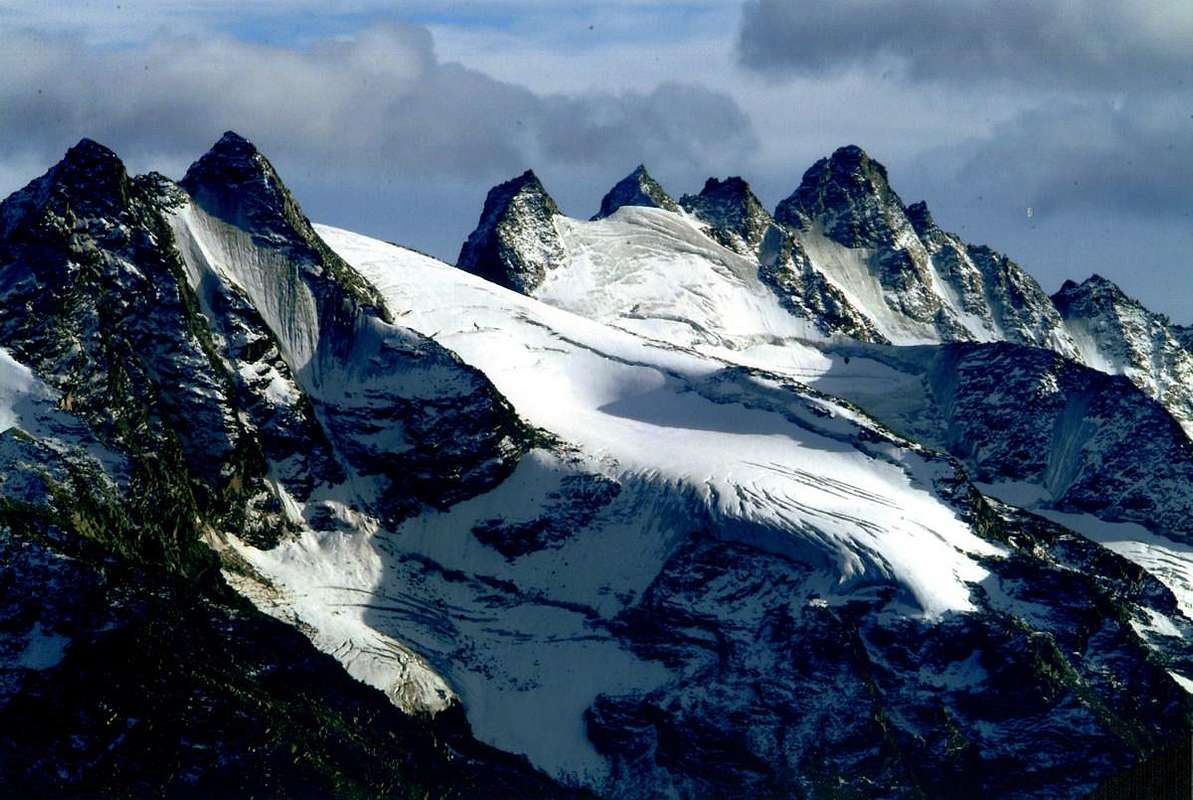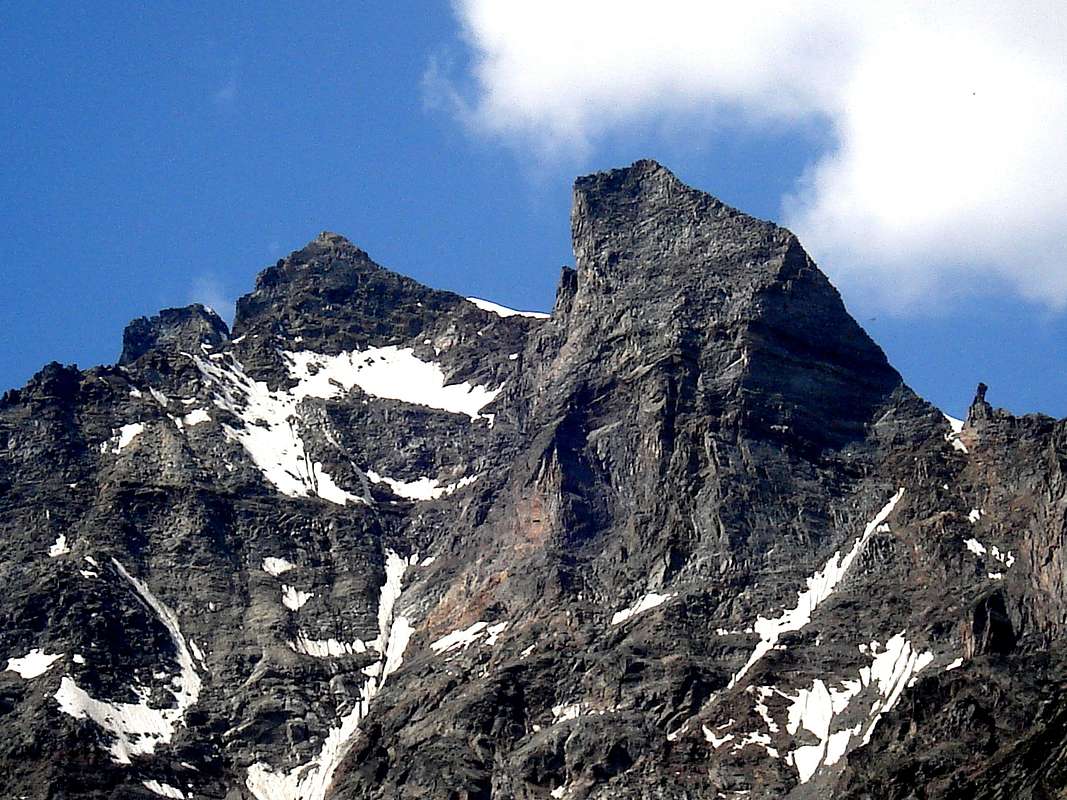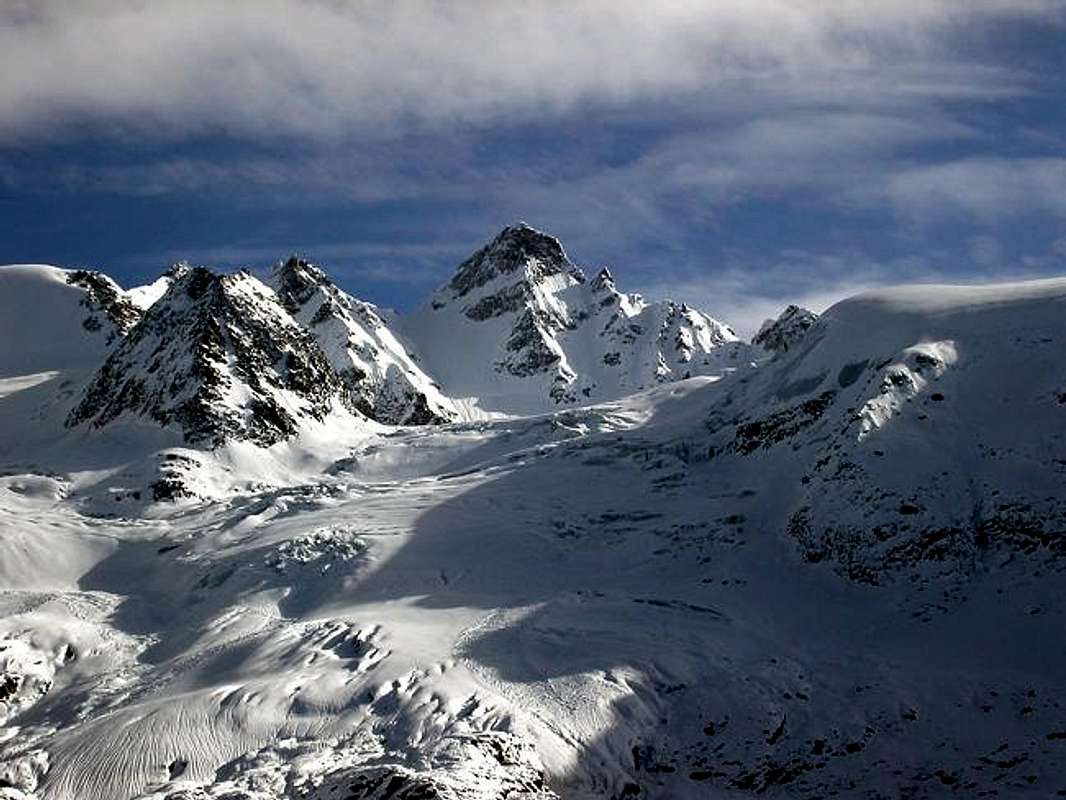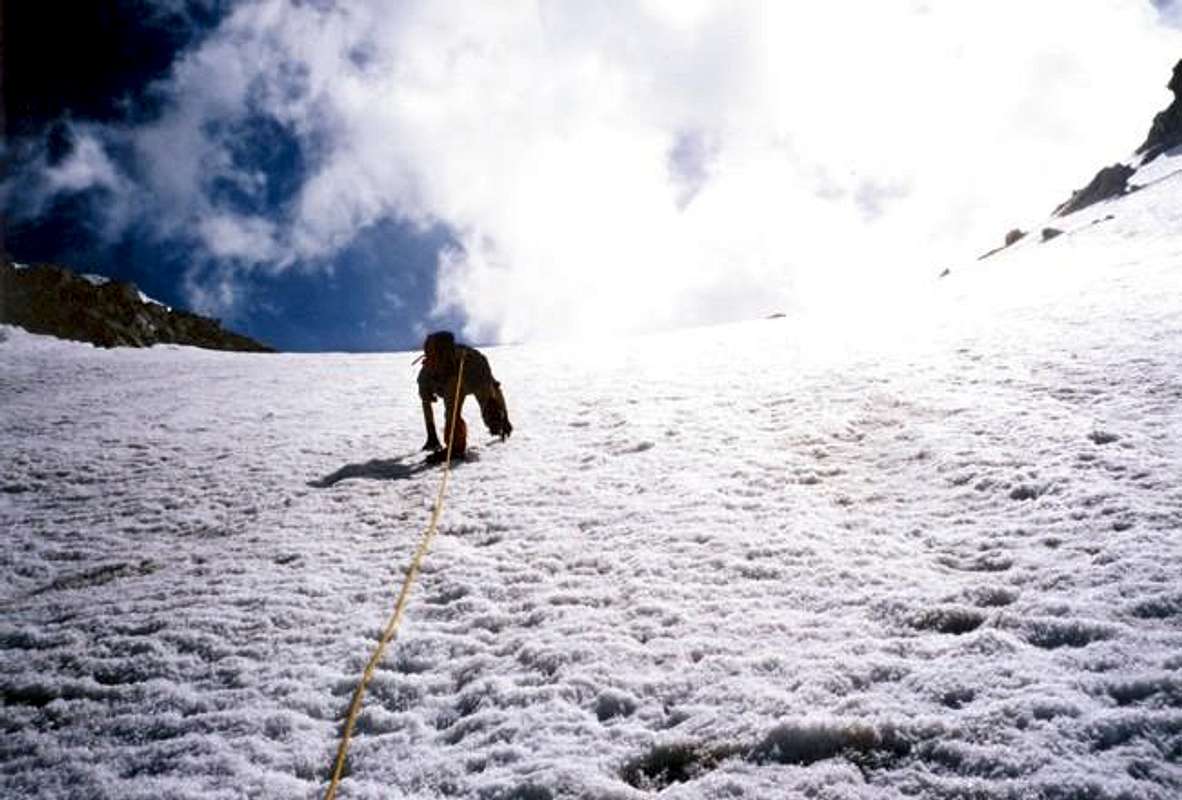Perché Apostoli? E quali e quanti son? Nella lunga prima parte od Orientale del divisorio tra le Regioni Piemonte e Val d'Aosta lo spartiacque dalla piccola Cima del Bec Renon
, sopra Pont St. Martin e Quincinetto (Canavese in Piemonte), formando per strada Sommità importanti come Rosa dei Banchi, Torre di Lavina, Grande Arolla, Punte delle Sengie e di Valeille, Ondezana, Gran San Pietro, Roccia Viva e Becca di Gay, raggiunge la Vetta massima del Gran Paradiso
. Dalla
e tra i Colli di Ondezana-Teleccio (Est) e Col de Money, si distende verso Settentrione un lungo divisorio che raggiunge Lillaz, importante Frazione di Cogne. Questa lunga cresta funge da divisorio tra la Valnontey (Ovest) e l'opposta della Valeille, dominando rispettivamente i Ghiacciai di Money tra Gran San Pietro e Torre di Sant'Orso, contenuto a Nord dalla Cresta Paganini, e del Coupé de Money tra quest'ultima e le Punte Patrì, al di sotto di quella Faccia Nordovest abitualmente utilizzata per la discesa. Sul versante opposto, o di Valeille esiste il piccolo Ghiacciaio omonimo, che scende al di sotto del Colle di Teleccio e sopra il Bivacco Antoldi-Malvezzi, in corrispondenza del primo settore; tra le due ultime torri si trova incastonato il minuscolo Glaciers des Tours, ormai ridotto a ben misera cosa, che si esaurisce sopra al grande pendio morenico chiamato
. L'insieme di queste tre torri, delle quali una duplice,
Why Apostles? Where does this name is somewhat controversial. Some say, the Summit appointed lower
Twelve Apostles, the Great Saint Peter became such, being the highest (
"Guide RAVA" 1930/32 and 1964, p. 290 by
Mario Aldrovandi; others, like the Poet-Writer
Giacomo Giacosa, that, following the discovery thereupon of ancient documents in Cogne, derives from the dialect
"Peirro", also stone. The
"Guide Gran Paradiso", 1939, 1963 and 1980 in pag.422 accepts both hypotheses uniting; with a
Renato Chabod, coauthor with Emanuele Andreis and Carlo Maria Sandri, which strangely is cautious in a field which is somewhat much informed. Prudence owned good mountaineer ... The same, however, suggest the crossing, debunking the same a little compared to the assessments of the past and doing the same considerations as above; the proposal, however, is different from ours remaining along the watershed through the Ridges Southwest and the Southeast from Teleccio. The legendary
B & V 1986, that the people of Turin Giovanni Luigi Bobba and Vaccarone
"glissando" (diverting) on the topic in the pages 76/79, where, however, it appears the unusual name of
Pic du Coupé for Torre Sant'Orso appears while the
"Pic du Retour" on the West Crest (Southwest) Great St Peter from the
Hill of Money. Finally
Umberto Pelazza in the book edited in December 2011 with the C.A.I. Aosta Section
"Who knows why it is called so" on page 119 contests
"a heavenly representation of the entire alpine kingdom" and also leads the
Gran Paradiso as not to
"Paradise of the Ibexes", wanted the
Canon Frutaz, but simply the Italian version of
"Grande Paroi or Granta Parey", or Great Wall. However admits, pages 127/8, the opinion of the illustrious Geologist
Martino Baretti (1841-1905) that talks about that ten tips that keep company to the first Pope; by appealing to the
Court of the Apostles mentions a famous intruder (Sant'Orso), Patron of Cogne but also of Derby and Jovençan, and also to the
Finger of the Apostles, he pointed at the Sky to the
Coupé de Money. If he says Martin, who is the
"older", he's right.
"The seniority that makes able". For the Umberto Pelazza, smelling of clerical also to Punte Patrì, former Pene Blanche, but here the
"snag" has never been solved and continue to wander in the Mystery,
hoping in the protection of the Holy Apostles ...
![]() Gran San Pietro (right) towards Sant'Andrea & Sant'Orso up to the Pointes Patrì,
Gran San Pietro (right) towards Sant'Andrea & Sant'Orso up to the Pointes Patrì,
by emilius
Perché Apostoli? Da cosa derivi questo toponimo risulta alquanto controverso. Qualcuno afferma che, nominate le Sommità inferiori
Dodici Apostoli, il Gran San Pietro divenne tale, essendone il più elevato (
"Guida R.A.V.A." 1930/32 e 1964, pag. 290 di
Mario Aldrovandi; altri, come il Poeta-Scrittore
Giacomo Giacosa, che, a seguito del ritrovamento in merito d'antichi documenti in Cogne, derivi dal dialettale
"Peirro", cioé pietra. La
"Guida Gran Paradiso" 1939, 1963 e 1980, pag.422 accetta entrambe le ipotesi unendole; con un
Renato Chabod, coautore con Emanuele Andreis e Carlo Maria Sandri, che stranamente non si sbilancia in un campo nel quale é alquanto ferrato. Prudenza del buon Montanaro ... Lo stesso consiglia però la traversata, smitizzandola un pò rispetto alle valutazioni del passato ed effettuando le medesime considerazioni di qui sopra; la sua proposta però é diversa dalla nostra rimanendo sempre in cresta tramite quella Sudovest o la Sudest dal Teleccio. I mitici
B & V 1896, ovvero i torinesi Giovanni Bobba e Luigi Vaccarone, "glissano" sull'argomento tra le pagine 76/79, dove però trovasi la denominazione inusuale di
Pic du Coupé per la Torre di San Orso mentre appar il
"Pic du Retour" sulla Cresta Ovest (Sudovest) del Gran San Pietro dal
Colle di Money. Infine
Umberto Pelazza in "Chissà perché si chiama così", editata in Dicembre 2011 sotto l'egida del C.A.I. Sezione d'Aosta, a pagina 119 contesta
"una rappresentazione tutta alpina del regno dei cieli" e riconduce anche il
Gran Paradiso non come al
"Paradiso degli Stambecchi", come voleva il
Canonico Frutaz, bensì semplicemente alla versione italiana di
"Grande Paroi o Granta Parey", ovvero Grande Parete. Però ammette, alle pagine 127/8, il parere dell'illustre Geologo
Martino Baretti (1841-1905) che parla di quella decina di punte che tengono compagnia al primo Papa; appellandosi alla
Corte degli Apostoli accenna ad un illustre intruso (Sant'Orso), Patrono di Cogne ma pure di Derby e Jovençan, ed anche al
Dito degli Apostoli, puntato contro il Cielo al
Coupé de Money. Se lo dice il più che esperto Martino, che é il "più vecchio", ha ragion lui.
"Per anzianità che fà grado". Per l'Umberto Pelazza, odoran di clericale anche le Punte Patrì, ex Pene Blanche, ma qui il
"busillis" non é mai stato risolto e continua a vagare nel più profondo Mistero,
sperando nella superior protezione dei Santi Apostoli ...
![]() Sant'Andrea & Sant'Orso Towers with "Dito degli Apostoli" (Apostle's Finger),
Sant'Andrea & Sant'Orso Towers with "Dito degli Apostoli" (Apostle's Finger),
by OliettiPaoloWhat and how many?
![]() Gran San Pietro (left) towards Sant'Andrea & Sant'Orso up to the Apostle's Finger on Coupé de Money Pass,
Gran San Pietro (left) towards Sant'Andrea & Sant'Orso up to the Apostle's Finger on Coupé de Money Pass,
by Antonio
And what and how many? To unravel this
"intrigue" we are equipped with Sainte Patience ... Lugs & Axe. The only thing to be able to check everything is to go up. So I began to cut steps in the ice to go and check in person, upwards on St. Peter highest Tower. Mario will be right or Giacomo, or is better, says Renato, give reason to both. Martin speaks of
"the ten tips that keep company to the first historic Pope", ie the Great Saint Peter. But 10 plus 1 makes 11 and instead the
Court of the Apostles is made up of 12, then one is missing. Disappeared? No, excluded because up there on the Gran Paradiso or Great Heaven Judas Iscariot not accept them. And others who are they? From our inspection made by the top or by the Pope's hat we deduced so: one is San Pietro, the other two St. Andrew and Holy Bear, then add the twins Tips Patrì, which are twofold but always count for one, the flirtatious Punta Cissetta, the number of Cardinals made up of bits Valeilles and Scatiglion, the Tip of Sengie reach Punta Ondezana, that
"hangs down" in the East (left facing) and seems to fall from one moment to another as the more than famous and renowned
Tower of Pisa. Fortunately on the other side are the counterpart robust Viva Rock, always well backed by neighboring Becca Gay. And the Beak of Patience, because for the poor Saint Peter to hold off all this realm it needs a lot. Three (Peter, Andrew, Bear) plus two (Patrì and Cissetta) make five which, added to the last three (Roccia Viva, Gay and Patience), lead us to eight. We add the Summits of Sengie, Valeilles, Scatiglion and Ondezana and we just, very just to the
Twelve. We solved the
"snag or busillis" and they were right both Mario and Giacomo that Martino. The Renato, from experienced ice climber, had all understood immediately, while Umberto had rightly denounced the
"encroachment of the Vatican on Kingdom Gran Paradiso". And Judas Iscariot what one knows? Anything. Someone identifies with the Sant'Andrea Tower that is
"double", someone else with Patrì that they also have
"double or reversibleface". We, looking from the top, we would say that is there in the midst of the Pointes de Valeille that,
like the Cardinals, you never know how many are ...
![]() Apostles Chain from Gran San Pietro (right) towards two Sant'Andrea & up to the "Paganini Crest" (more in bottom to the left),
Apostles Chain from Gran San Pietro (right) towards two Sant'Andrea & up to the "Paganini Crest" (more in bottom to the left),
by Antonio
Quali e quanti son gli Apostoli? Per dipanare sto
"intrigo" ci siam muniti di Santa Pazienza e ... Ramponi & Piccozza. L'unica cosa per poter verificare il tutto consiste nel salire. Così ci siam messi furiosamente ad intagliar gradini nel ghiaccio per andar controllare di persona, sù al San Pietro. Avrà ragione Mario o Giacomo, oppure é meglio, come dice Renato, dar la ragione ad entrambi. Martino parla di
"quella decina di punte che tengono compagnia al primo storico Papa", cioé il Grande San Pietro. Ma 10 più 1 fà 11 ed invece la
Corte degli Apostoli é composta da 12, quindi ne manca uno. Scomparso? No, escluso perché lassù sul Gran Paradiso i Giuda Iscariota non li accettano proprio. E gli altri chi sono? Dalla nostra ispezione fatta dall'alto ovvero dal cappello del Papa abbiamo dedotto così: uno é il San Pietro, gli altri due i San Andrea ed il Santo Orso, poi aggiungiamo le gemelle Punte Patrì, che son duplici ma contan sempre per una, la civettuola Punta Cissetta, quella serie di Cardinali costituita dalle Punte Valeilles e Scatiglion, che dalla Punta delle Sengie raggiungono l'Ondezana, che
"pende" ad Est (sempre sinistra guardando) e sembra cader da un momento allo altro come la ben più famosa
Torre di Pisa. Per fortuna sul versante opposto fan da contrappeso la robusta Roccia Viva, sempre ben spalleggiata dalla vicina Becca di Gay. Ed il Becco della Pazienza, perché per il povero San Pietro per tenere a bada tutto sto sconvolto reame ne ha bisogno più che di molta. Tre (Pietro, Andrea, Orso) più due (Patrì e Cissetta) fan cinque che, sommate all'ultime tre (Viva, Gay e Pazienza), ci portan ad otto. Aggiungiamo le Sengie, Valeilles, Scatiglion ed Ondezana e siam giusti, proprio giusti a
Dodici. Abbiam risolto il
"busillis" ed avevano ragione sia il Mario ed il Giacomo che il Martino. Il Renato, da ghiacciatore esperto, l'aveva capito subito, mentre Umberto aveva giustamente denunciato all'opinione pubblica l'
"invadenze del Vaticano sul Granpa". E di Giuda Iscariota cosa si sà? Niente. Qualcuno l'individua con la Sant'Andrea che é
"doppia", qualcun altro colle Patrì che pur possiedon double-face. Noi, guardando dall'alto, diremmo che si trova là in mezzo a quella serie di Punte Valeilles che,
come i Cardinali, non si capisce mai quanti son ...
![]() Ascension towards the First Pope or Gran San Pietro Tower,
Ascension towards the First Pope or Gran San Pietro Tower,
by Sandrino "Lupetto" Casalegno
Comments
No comments posted yet.
